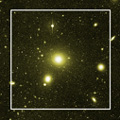CXC Home | Search | Help | Image Use Policy | Latest Images | Privacy | Accessibility | Glossary | Q&A

Dissolve from Optical to X-ray View of Fornax
QuickTime MPEG This sequence begins with a wide-field, visible light view (yellow) of the Fornax galaxy cluster. Next, it zooms into the region Chandra observed in X-rays (blue). Scientists think the core of the cluster, labeled as NGC 1399, is moving to the lower right on a collision course with another group of galaxies seen only in the optical data. This indicates that the cluster lies along a large, unseen, filamentary structure composed mostly of dark matter that is pulling everything toward it. Two other galaxies in the Fornax cluster are labeled: NGC 1404 and NGC 1387.
[Run Time: 0:11]
(Credits: Optical: Pal.Obs. DSS;
X-ray: NASA/CXC/Columbia U./C.Scharf et al.)
QuickTime MPEG This sequence begins with a wide-field, visible light view (yellow) of the Fornax galaxy cluster. Next, it zooms into the region Chandra observed in X-rays (blue). Scientists think the core of the cluster, labeled as NGC 1399, is moving to the lower right on a collision course with another group of galaxies seen only in the optical data. This indicates that the cluster lies along a large, unseen, filamentary structure composed mostly of dark matter that is pulling everything toward it. Two other galaxies in the Fornax cluster are labeled: NGC 1404 and NGC 1387.
[Run Time: 0:11]
(Credits: Optical: Pal.Obs. DSS;
X-ray: NASA/CXC/Columbia U./C.Scharf et al.)
Return to Fornax Cluster (08 Sep 04)


